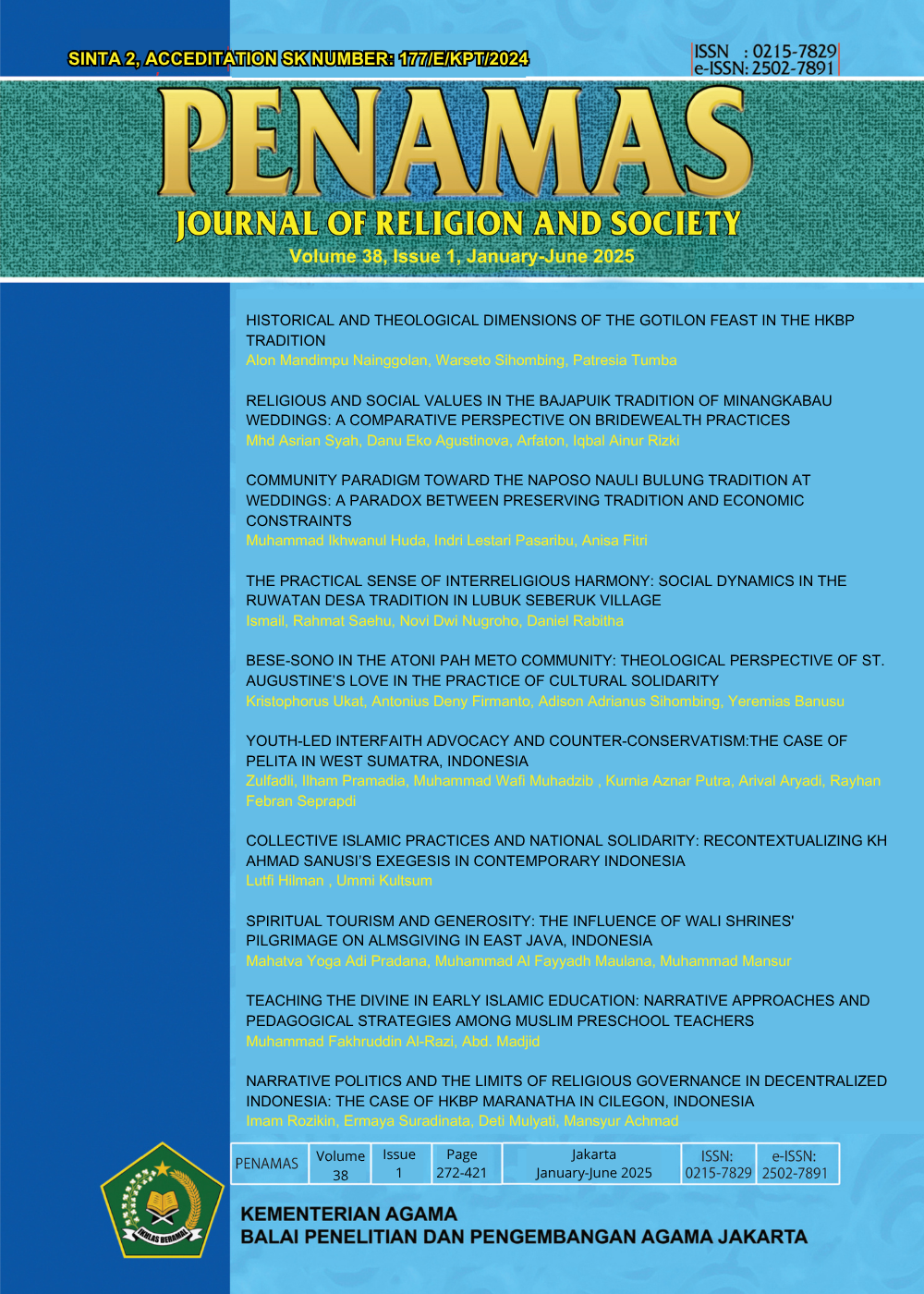TEACHING THE DIVINE IN EARLY ISLAMIC EDUCATION: NARRATIVE APPROACHES AND PEDAGOGICAL STRATEGIES AMONG MUSLIM PRESCHOOL TEACHERS
DOI:
https://doi.org/10.31330/penamas.v38i1.787Keywords:
divinity education, divinity conception, development of divinity conception, educational narrative, educational approachAbstract
Teaching the concept of divinity in Islam, which tends to be abstract, to preschool children is a challenge, given their immature cognitive modalities. To this end, this article explores teachers' approaches and narrative models used in providing divinity education to Muslim children. Semi-structured interviews with Muslim teachers who have more than one year of experience teaching preschool children show that the approaches and narrative models used by the teachers vary widely and tend to be eclectic. Teachers tend to introduce and relate children to the concept of divinity through habituation and religious terms rather than teaching the concept of divinity in detail to children. The approaches used by teachers are linguistic and habituation approaches. The narratives used are body analogies, natural phenomena, simple associations, and chants or nadzam (Arabic poetry) that are recited and memorized together. These findings make an important contribution to the development of contextualized and developmentally appropriate divinity education methods in an Islamic cultural environment.
References
Al-Alusi, S. M. (2014). Ruhul Ma’ani fi Tafsir Al-Qur’an Al-Adzim wa Sab’u Al-Matsani (Vol. 4). Darul Kutub Al-Ilmiyah.
al-Marzuki, A. (2012). Aqidatul Awam. Al-Miftah.
Armstrong, K. (2011). Sejarah Tuhan: Kisah 4.000 Tahun Pencarian Tuhan dalam Agama-agama Manusia (Z. Am, Ed.). Mizan.
Bader, C. D., & Desmond, S. A. (2006). Do as I Say and as I Do: The Effects of Consistent Parental Beliefs and Behaviors upon Religious Transmission. Sociology of Religion, 67(3), 313–329. https://doi.org/10.1093/socrel/67.3.313
Bandura, A. (1969). Social-Learning Theory of Identificatory Processes. In D. A. Goslin (Ed.), Handbook of Socialization Theory and Research (pp. 213–264). Rand McNally & Company.
Baring, R. (2012). Children’s image of God and their parents: explorations in children’s spirituality. International Journal of Children’s Spirituality, 17(4), 277–289. https://doi.org/10.1080/1364436X.2012.746935
Barrett, J. L., & Richert, R. A. (2003). Anthropomorphism or Preparedness? Exploring Children’s God Concepts. Review of Religious Research, 44(3), 300. https://doi.org/10.2307/3512389
Bjorklund, D. F. (2022). Children’s Thinking: Cognitive Development and Individual Differences (7th Edition). SAGE Publications, Inc.
Bloom, P. (2007). Religion is natural. Developmental Science, 10(1), 147–151. https://doi.org/10.1111/j.1467-7687.2007.00577.x
Braun, V., & Clarke, V. (2006). Using thematic analysis in psychology. Qualitative Research in Psychology, 3(2), 77–101. https://doi.org/10.1191/1478088706qp063oa
Bronfenbrenner, U. (1979). Understanding children in context: The ecological model of human development. In Harvard University Press.
Burdett, E. R. R., Barrett, J. L., & Greenway, T. S. (2020). Children’s Developing Understanding of the Cognitive Abilities of Supernatural and Natural Minds. Journal for the Study of Religion, Nature and Culture, 14(1), 124–151. https://doi.org/10.1558/jsrnc.39186
Chaisricharoen, R., Srimaharaj, W., & Sohail, A. (2019). Association between Different Learning Methods and Testing Scores for Student: A Case Study. 2019 16th International Conference on Electrical Engineering/Electronics, Computer, Telecommunications and Information Technology (ECTI-CON), 401–404. https://doi.org/10.1109/ECTI-CON47248.2019.8955391
Christian, B. J. (2020). Attachment, Nature, and the Young Child’s Felt Sense of God. Journal of Research on Christian Education, 29(1), 47–60. https://doi.org/10.1080/10656219.2020.1731031
Clandinin, D. J., Pushor, D., & Orr, A. M. (2007). Navigating Sites for Narrative Inquiry. Journal of Teacher Education, 58(1), 21–35. https://doi.org/10.1177/0022487106296218
Cui, Y. K., Clegg, J. M., Yan, E. F., Davoodi, T., Harris, P. L., & Corriveau, K. H. (2020). Religious testimony in a secular society: Belief in unobservable entities among Chinese parents and their children. Developmental Psychology, 56(1), 117–127. https://doi.org/10.1037/dev0000846
De Roos, S. A., Iedema, J., & Miedema, S. (2001). Young Children’s Descriptions of God: influences of parents’ and teachers’ God concepts and religious denomination of schools. Journal of Beliefs and Values, 22(1), 19–30. https://doi.org/10.1080/1361760120039211
DOGAN, R. N. (2023). God and Child: Children’s God Concept and Deadlock of Cognitive Stage Theories. Journal of Ilahiyat Researches, 1(59), 54–60. https://doi.org/10.5152/ilted.2023.22194
Goldman, R. (2022). Religious Thinking from Childhood to Adolescence. Routledge. https://doi.org/10.4324/9781003260684
Hamdanah. (2020). Psikologi Perkembangan Agama: Sebuah Tahapan Perkembangan Agama Manusia. K-Media.
Harms, E. (1944). The Development of Religious Experience in Children. American Journal of Sociology, 50(2), 112–122. https://doi.org/10.1086/219518
Harms, E. (1966). Five Basic Types of Theistic Worlds in the Religions of Man. Numen, 13(3), 205. https://doi.org/10.2307/3269489
James, E. O. (2020). The Concept of Deity. Routledge. https://doi.org/10.4324/9781003071570
Karsten, R. (2020). The Origins of Religion. Routledge. https://doi.org/10.4324/9781003071587
Kim, J.-H. (2016). Locating Narrative Inquiry in the Interdisciplinary Context. In Understanding Narrative Inquiry: The Crafting and Analysis of Stories as Research (pp. 1–25). SAGE Publications, Inc. https://doi.org/10.4135/9781071802861.n1
Kirkpatrick, L. A. (2019). An attachment-theory approach to the psychology of religion. In The Psychology of Religion. https://doi.org/10.4324/9780429495915-10
Kusainun, N., & Berngacha, S. (2023). Introducing Children to Allah: Developing Religious Spirit in Elementary School Through Teaching Tawheed at Home. Jurnal Praktik Baik Pembelajaran Sekolah Dan Pesantren, 2(02), 52–61. https://doi.org/10.56741/pbpsp.v2i02.292
Lam, V. L., & Guerrero, S. (2020). Animals, Superman, Fairy, and God: Children's Attributions of Nonhuman Agent Beliefs in Madrid and London. Journal of Cognition and Culture, 20(1–2), 66–87. https://doi.org/10.1163/15685373-12340074
Lee, H. J., Marin, A. B., Sun, J., & Richert, R. A. (2023). Does God Comfort You When You Are Sad? Religious Diversity in Children’s Attribution of Positive and Negative Traits to God. Religions, 14(9), 1181. https://doi.org/10.3390/rel14091181
Moriguchi, Y. (2022). Visual image of God/gods during early childhood. International Journal of Psychology, 57(6), 693–699. https://doi.org/10.1002/ijop.12869
Muhammad, A., Dartim, & Mustofa, T. A. (2024). The Inculcation of Aqidah Values Using the Book of Aqidatul Awam (pp. 499–505). https://doi.org/10.2991/978-2-38476-102-9_45
Murphy, R. J. L. (1978). A New Approach to the Study of the Development of Religious Thinking in Children. Educational Studies, 4(1), 19–22. https://doi.org/10.1080/0305569780040103
Nye, W. C., & Carlson, J. S. (1984). The Development of the Concept of God in Children. The Journal of Genetic Psychology, 145(1), 137–142. https://doi.org/10.1080/00221325.1984.10532259
Nyhof, M. A., & Johnson, C. N. (2017). Is God just a big person? Children’s conceptions of God across cultures and religious traditions. British Journal of Developmental Psychology, 35(1), 60–75. https://doi.org/10.1111/bjdp.12173
Piaget, J. (1929). The Child Conception of the World. Harcourt Brace.
Saide, A. R., & Richert, R. (2022). Correspondence in parents' and children's concepts of god: Investigating the role of parental values, religious practices, and executive functioning. British Journal of Developmental Psychology, 40(3), 422–437. https://doi.org/10.1111/bjdp.12415
Saide, A. R., & Richert, R. A. (2020). Socio-Cognitive and Cultural Influences on Children’s Concepts of God. Journal of Cognition and Culture, 20(1–2), 22–40. https://doi.org/10.1163/15685373-12340072
Schilbrack, K. (2022). The Concept of Religion. In E. N. Zalta (Ed.), Stanford Encyclopedia of Philosophy. Metaphysics Research Lab, Stanford University. https://plato.stanford.edu/archives/sum2022/entries/concept-religion/
Susanti, R., & Ikhwanisifa, I. (2020). The concept of God: From the lens of students of integrated Islamic elementary schools. HUMANITAS: Indonesian Psychological Journal, 17(1), 46. https://doi.org/10.26555/humanitas.v17i1.8916
Wolle, R. G., McLaughlin, A., & Heiphetz, L. (2021). The Role of Theory of Mind and Wishful Thinking in Children’s Moralizing Concepts of the Abrahamic God. Journal of Cognition and Development, 22(3), 398–417. https://doi.org/10.1080/15248372.2021.1888731
Zuhaili, W. (2009). At-Tafsir Al-Munir (Vol. 8). Dar Al-Fikr.
Downloads
Published
Issue
Section
License
Copyright (c) 2025 Penamas

This work is licensed under a Creative Commons Attribution-NonCommercial-ShareAlike 4.0 International License.









